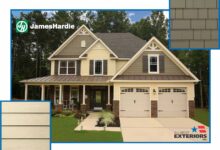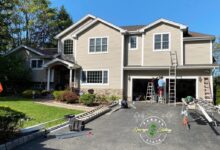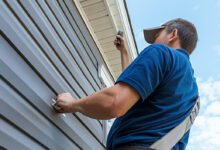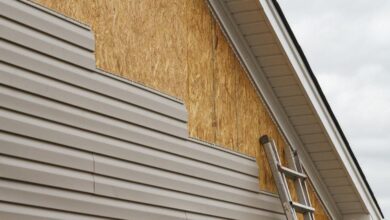Siding Installation: A Comprehensive Guide
Siding installation is more than just covering your home’s exterior; it’s about enhancing its curb appeal, protecting it from the elements, and increasing its value. This guide delves into the intricacies of siding, from choosing the right material and understanding the installation process to budgeting, finding a reliable contractor, and ensuring long-term maintenance. We’ll explore various siding types, their pros and cons, and how to navigate the complexities of building codes and permits. Prepare to transform your home’s exterior with informed decisions and a comprehensive understanding of siding installation.
Whether you’re a homeowner tackling a DIY project or collaborating with a professional contractor, this guide provides the essential knowledge to make informed choices throughout the entire process. From selecting the ideal siding material based on your climate and budget to understanding the step-by-step installation procedure, we cover all the crucial aspects. We’ll also explore the aesthetic considerations, ensuring your new siding complements your home’s architectural style and enhances its overall charm.
Types of Siding Materials
Choosing the right siding for your home is a crucial decision impacting aesthetics, durability, and long-term maintenance. Several materials offer distinct advantages and disadvantages, depending on your budget, climate, and personal preferences. This section compares popular siding options: vinyl, fiber cement, wood, and metal.
Siding Material Comparison
| Material | Lifespan (Years) | Maintenance | Cost (per sq ft) |
|---|---|---|---|
| Vinyl | 20-40 | Low; occasional cleaning | $2-$6 |
| Fiber Cement | 50-80 | Moderate; periodic painting or staining | $4-$12 |
| Wood | 20-50 (depending on type and maintenance) | High; regular painting, staining, and potential repairs | $3-$10+ |
| Metal | 50+ | Low; occasional cleaning and minor repairs | $5-$15+ |
Siding Styles and Textures
The appearance of siding significantly contributes to a home’s curb appeal. Vinyl siding offers a wide range of styles mimicking wood clapboard, shingle, or even stone textures. Fiber cement siding provides similar versatility, often replicating the look of wood shakes or traditional lap siding. Wood siding, naturally, presents many options from smooth planks to rough-hewn shakes, and even intricate patterns. Metal siding can mimic various textures, such as wood grain or stucco, and is also available in sleek, modern profiles.
Siding Material Performance in Different Climates
Climate significantly influences siding material selection. Vinyl siding performs well in moderate climates but can become brittle in extremely cold conditions or warp in intense heat. Fiber cement, known for its durability, withstands harsh weather including extreme temperatures, humidity, and strong winds, making it suitable for a wide range of climates. Wood siding, while aesthetically pleasing, requires more maintenance in humid or rainy climates to prevent rot and insect infestation. Metal siding, with its inherent strength and resistance to moisture and fire, is a strong contender for regions prone to severe weather events. For example, metal siding is often preferred in hurricane-prone coastal areas.
Siding Installation Process
Siding installation is a multifaceted process requiring careful planning and execution to ensure a durable and aesthetically pleasing exterior for your home. Proper installation protects your home from the elements and significantly impacts its curb appeal. This section details the steps involved in a typical siding installation project, from initial preparation to final finishing touches.
A successful siding installation hinges on meticulous preparation and the use of appropriate tools and techniques. Overlooking any stage can compromise the final result, leading to potential issues such as leaks, warping, or an unprofessional appearance.
Necessary Tools and Equipment
Having the right tools is crucial for efficient and effective siding installation. The proper equipment ensures a clean, precise, and safe working environment. Improper tools can lead to damage, delays, and safety hazards.
- Measuring tape and level
- Chalk line
- Circular saw or miter saw
- Jigsaw
- Drill with various drill bits
- Hammer
- Nail gun (recommended for efficiency)
- Safety glasses and gloves
- Ladder (appropriate height for the building)
- Caulk gun
- Putty knife
- Utility knife
- Scissors
Vinyl Siding Installation on a Single-Story House: A Step-by-Step Guide
This guide outlines the process of installing vinyl siding on a single-story house. Remember to always consult the manufacturer’s instructions for your specific siding product, as variations may exist.
- Preparation: This involves removing old siding (if applicable), inspecting the underlying sheathing for damage, and repairing any necessary areas. Ensure the sheathing is clean, dry, and structurally sound. This foundational step is crucial for a long-lasting installation.
- Starter Strip Installation: Install the starter strip along the bottom of the house, ensuring it’s level and aligned. This provides a foundation for the remaining siding panels.
- J-Channel Installation: Install J-channel around windows and doors. This creates a clean, finished look and protects the edges of the siding.
- Siding Panel Installation: Begin installing siding panels, working from bottom to top and overlapping each panel according to manufacturer’s specifications. Use appropriate fasteners and ensure proper alignment. This is the most time-consuming part of the process.
- Corner Installation: Install corner trim pieces to create a neat, finished look at the corners of the house. These pieces provide additional protection and enhance aesthetics.
- Finishing Touches: Install any remaining trim pieces, such as fascia and soffit, and apply caulk to seal any gaps or seams. A thorough inspection is crucial at this stage to ensure a complete and watertight seal.
Cost Considerations for Siding Installation
Choosing new siding is a significant home improvement investment. Understanding the associated costs is crucial for budgeting and planning your project effectively. This section details the various factors influencing the overall expense of siding installation, providing a framework for making informed decisions.
The total cost of siding installation is highly variable, depending on several interconnected factors. A simple project on a small house will naturally cost less than a complex renovation on a large, multi-story home. Material selection plays a dominant role, with some options significantly more expensive than others. Labor costs, influenced by location and contractor demand, also add to the overall expense.
Average Cost Per Square Foot for Different Siding Materials
The following table provides a general estimate of siding installation costs per square foot. Keep in mind that these are averages, and actual costs can vary based on the factors discussed below. Prices are in US dollars and are estimates based on data collected from various reputable sources in 2024.
| Siding Material | Material Cost per sq ft | Installation Cost per sq ft | Total Cost per sq ft (Estimate) |
|---|---|---|---|
| Vinyl | $1-$4 | $3-$6 | $4-$10 |
| Fiber Cement | $2-$8 | $5-$10 | $7-$18 |
| Wood | $3-$15 | $7-$15 | $10-$30 |
| Metal (Aluminum or Steel) | $2-$10 | $6-$12 | $8-$22 |
| Engineered Wood | $4-$10 | $8-$15 | $12-$25 |
Factors Influencing Overall Cost
Several key factors significantly impact the final cost of your siding project. Accurate cost estimation requires careful consideration of these elements.
Labor Rates: Labor costs vary widely depending on geographic location, contractor experience, and project complexity. Highly skilled installers in high-demand areas command higher rates. For example, a contractor in a major metropolitan area might charge considerably more per hour than one in a rural setting.
Material Prices: Material costs fluctuate based on market conditions and supply chain dynamics. Popular siding materials may experience price increases during peak construction seasons. Choosing less common materials might offer cost savings, but careful consideration of their longevity and maintenance needs is essential.
Project Complexity: The complexity of your project significantly affects labor costs. Factors such as the size and shape of your house, the need for extensive repairs or removal of existing siding, and the presence of intricate architectural details all contribute to increased labor time and, consequently, higher costs. A simple, rectangular home will generally cost less to side than one with numerous dormers, bay windows, or other complex features.
Potential Cost-Saving Measures
Homeowners can employ several strategies to reduce costs without sacrificing quality. Careful planning and informed decision-making are key to maximizing value.
Choosing Less Expensive Materials: Opting for more budget-friendly materials like vinyl siding can significantly reduce the overall cost compared to premium options like natural wood. However, it’s crucial to weigh the long-term costs of maintenance and potential lifespan differences.
DIY Installation (With Caution): While tempting, DIY siding installation is only recommended for experienced homeowners with the necessary skills and tools. Improper installation can lead to costly repairs and compromise the longevity and effectiveness of your new siding.
Shop Around for Contractors: Obtaining multiple quotes from reputable siding contractors allows for price comparison and identification of the best value. Ensure that quotes include detailed breakdowns of labor and material costs to facilitate informed decision-making.
Negotiate Prices: Don’t hesitate to negotiate with contractors. Presenting multiple quotes can provide leverage in securing a more favorable price. Clearly communicate your budget and priorities to ensure a mutually beneficial agreement.
Choosing a Siding Contractor
Selecting the right siding contractor is crucial for a successful and long-lasting siding installation. A reputable contractor ensures quality materials, professional workmanship, and adherence to timelines, ultimately protecting your investment and enhancing your home’s curb appeal. Choosing poorly can lead to costly repairs, aesthetic issues, and significant headaches.
Finding a qualified and trustworthy siding contractor requires careful research and due diligence. This involves checking credentials, verifying experience, and understanding their approach to the project. Taking the time to properly vet potential contractors will pay dividends in the long run.
Contractor Credentials and Experience Verification
Verifying a contractor’s credentials and experience is paramount. This involves checking for proper licensing and insurance, confirming years of experience in siding installation, and reviewing their portfolio of past projects. A licensed and insured contractor demonstrates a commitment to professionalism and provides financial protection in case of accidents or damages during the installation process. Requesting references and contacting previous clients to inquire about their experiences is another valuable step. Look for contractors with a proven track record of successful projects similar in scope and scale to your own. For example, a contractor with extensive experience in installing fiber cement siding would be a better choice for a large, multi-story home than one primarily focused on vinyl siding installations in smaller residences.
Questions to Ask Potential Siding Contractors
Before committing to a contractor, a comprehensive list of questions should be addressed to ensure a clear understanding of their services and approach. This proactive step helps avoid misunderstandings and potential problems down the line. These questions should cover aspects such as project timelines, warranty information, payment schedules, and the specifics of the materials used.
- What is your experience with installing [type of siding chosen] siding?
- Can you provide proof of licensing and insurance?
- May I see examples of your previous work, including projects similar to mine?
- What is your detailed project timeline, and what are the key milestones?
- What type of warranty do you offer on your workmanship and materials?
- What is your payment schedule, and what are the payment terms?
- What is your process for addressing unforeseen issues or complications during installation?
- What is your approach to waste removal and site cleanup?
- Do you provide a detailed written contract outlining all aspects of the project?
- What is your process for obtaining necessary permits?
The Importance of Obtaining Multiple Quotes and Comparing Services
Obtaining multiple quotes from different siding contractors is essential for making an informed decision. Comparing quotes allows you to evaluate the pricing, services offered, and overall value proposition of each contractor. This process shouldn’t solely focus on price; consider factors such as experience, reputation, warranty, and the overall communication and professionalism of the contractor. For instance, a slightly higher quote from a contractor with an excellent reputation and comprehensive warranty might be a better investment than a significantly lower quote from a less experienced or less reputable company. Comparing quotes enables a thorough cost-benefit analysis, leading to a more informed and financially sound decision.
Siding Maintenance and Repair
Proper siding maintenance is crucial for extending its lifespan and maintaining your home’s curb appeal. Neglecting maintenance can lead to costly repairs and even structural damage. Regular cleaning and prompt attention to minor issues can prevent significant problems down the line. This section details common siding problems, cleaning methods, and simple repair techniques.
Common Siding Problems and Their Causes
Various factors contribute to siding damage. These include weather exposure, insect infestations, and accidental impact. Understanding these causes allows for proactive maintenance and preventative measures.
- Cracks and Holes: These are often caused by impacts from falling debris, sports equipment, or even strong winds. Exposure to extreme temperature fluctuations can also lead to cracking, especially in older siding materials.
- Fading and discoloration: Prolonged exposure to sunlight, especially UV rays, causes fading and discoloration, particularly noticeable in lighter-colored sidings. Air pollution and mildew growth can also contribute to this issue.
- Water Damage: Improper installation, damaged flashing, or clogged gutters can lead to water seeping behind the siding, causing rot, mold, and structural damage. This is a particularly serious issue that requires prompt professional attention.
- Insect Infestations: Termites, carpenter ants, and other insects can burrow into siding, causing structural weakening and potential infestation of the underlying structure. Regular inspections are vital to detect and address these problems early.
- Loose or Damaged Siding Panels: High winds, settling foundations, or poor initial installation can cause siding panels to become loose or damaged. This can lead to further damage if not addressed promptly.
Cleaning and Maintaining Different Siding Materials
Different siding materials require specific cleaning methods. Using inappropriate cleaning solutions or techniques can damage the siding’s surface and reduce its lifespan.
- Vinyl Siding: Vinyl siding is relatively low-maintenance. Regular cleaning with a garden hose and a soft-bristled brush is usually sufficient. For tougher stains, a mild detergent solution can be used. Avoid abrasive cleaners or high-pressure washers, as these can damage the vinyl surface.
- Fiber Cement Siding: Fiber cement siding is more durable and resistant to damage than vinyl. It can be cleaned similarly to vinyl siding, using a garden hose and a soft-bristled brush. A pressure washer can be used cautiously, but always maintain a safe distance to avoid damaging the surface. Regularly inspect for cracks or damage.
- Wood Siding: Wood siding requires more frequent maintenance than vinyl or fiber cement. Regular cleaning with a mild detergent solution and a soft brush is necessary. Periodically, you may need to apply a wood sealant or stain to protect it from the elements and prevent rot or insect infestation. Consider professional help for extensive cleaning or repairs.
Repairing Minor Damage to Vinyl and Fiber Cement Siding
Minor damage to vinyl and fiber cement siding can often be repaired using simple DIY methods. However, for extensive damage, it’s best to consult a professional.
Vinyl Siding Repair: Small cracks or holes in vinyl siding can often be filled with a vinyl siding repair kit, which usually includes a patching compound and adhesive. Clean the damaged area, apply the adhesive, and then fill the crack or hole with the patching compound. Once dry, paint the repaired area to match the surrounding siding.
Fiber Cement Siding Repair: Minor cracks in fiber cement siding can be repaired with a patching compound specifically designed for this material. Clean the damaged area thoroughly, apply the patching compound, and allow it to dry completely. Once dry, sand the repaired area smooth and apply a primer and paint to match the surrounding siding. Larger holes or significant damage usually require professional repair or replacement of the entire panel.
Siding and Home Aesthetics
The exterior of your home makes a significant first impression, and siding plays a crucial role in shaping its curb appeal and overall market value. The right siding choice can dramatically enhance your home’s aesthetic, while a poor selection can detract from its beauty and potentially impact its resale price. Understanding the interplay between siding and home aesthetics is vital for both homeowners and those involved in property development.
Siding choices significantly impact curb appeal and home value. The material, color, and texture of the siding all contribute to the overall visual impact of a house. Homes with well-maintained, attractive siding tend to command higher prices on the market and attract more potential buyers. Conversely, outdated or damaged siding can significantly lower a home’s value and make it less appealing. This is because the exterior is often the first thing potential buyers notice.
Color Palettes and Their Effects
Strategic color selection for siding can greatly influence the overall feel and appearance of a home. A light color palette, such as creamy whites, soft grays, or light blues, can create a sense of spaciousness and airiness, particularly effective for smaller homes or those situated in densely populated areas. These colors reflect light, making the house appear brighter and more welcoming. In contrast, darker color palettes, like deep blues, greens, or browns, can create a more dramatic and sophisticated look, often suitable for larger homes or those with more prominent architectural features. These colors absorb more light, creating a more intimate and grounded feel. The choice of color should also consider the surrounding landscape and the style of the home.
Siding and Architectural Styles
Different architectural styles often benefit from specific siding materials, colors, and textures to enhance their unique characteristics.
For example, a Victorian home, known for its ornate detailing and intricate trim, might be complemented by wood siding in a rich, dark color such as deep brown or hunter green. The texture of the wood, perhaps with some natural weathering, would add to the home’s historical charm. The intricate detailing of the Victorian style would be enhanced by the natural variations in wood grain. Imagine the deep, warm tones of the wood contrasting beautifully with the lighter-colored trim work.
A Ranch style home, characterized by its low-pitched roof and horizontal lines, often looks best with horizontal lap siding. A neutral color palette, such as a light gray or beige, would accentuate the horizontal lines and create a clean, modern aesthetic. The smooth texture of vinyl or fiber cement siding would maintain a sleek and contemporary feel, perfectly suited to the style’s simple elegance. Imagine a light gray siding with crisp white trim, creating a feeling of openness and tranquility.
A Colonial style home, often featuring symmetrical facades and classic details, might benefit from vinyl or fiber cement siding in a classic white or off-white color. The smooth texture of these materials complements the home’s clean lines and symmetrical design. The subtle variations in color, such as cream or ivory, can add depth and visual interest without overwhelming the home’s classic aesthetic. Imagine the clean lines of the house highlighted by the bright white siding, a testament to timeless elegance.
Building Codes and Permits for Siding Installation
Navigating the world of building codes and permits might seem daunting, but understanding their importance is crucial for a successful and legally sound siding installation project. Obtaining the necessary permits before commencing work protects both the homeowner and the contractor, ensuring compliance with local regulations and preventing potential legal repercussions. This section outlines the key aspects of building codes and permits related to siding installation.
Building codes and regulations related to siding installation vary significantly depending on location (city, county, state). These regulations are designed to ensure public safety, structural integrity, and energy efficiency. They often address aspects such as the type of siding material allowed, its installation methods, fire resistance ratings, and the overall impact on the building’s structural stability. Failure to adhere to these regulations can result in serious consequences.
Common Building Code Requirements for Siding
Local building departments typically specify requirements for siding materials, installation techniques, and fire ratings. For example, some areas may prohibit the use of certain combustible materials in specific zones, or mandate the use of fire-retardant treatments for wood siding. Other regulations might address ventilation requirements behind the siding to prevent moisture buildup and rot, or dictate minimum clearances around windows and doors. It is vital to check with the local building department for specific requirements before starting any work. Ignoring these requirements could lead to project delays, costly modifications, or even the necessity of completely removing and reinstalling the siding.
Consequences of Non-Compliance
Failing to obtain the necessary permits or adhering to building codes can lead to a range of negative consequences. These can include hefty fines imposed by the building department, orders to cease work until permits are obtained and violations are rectified, and even legal action from neighbors or the municipality. In extreme cases, the homeowner may be forced to remove the improperly installed siding and reinstall it according to code, incurring significant additional expenses. Furthermore, insurance companies may refuse to cover damages caused by non-compliant installations, leaving the homeowner financially responsible for repairs or replacements. A seemingly small oversight can result in substantial financial and legal burdens.
Obtaining Building Permits
The process of obtaining a building permit typically involves submitting detailed plans and specifications of the siding project to the local building department. These plans should clearly outline the type of siding, installation methods, and any other relevant details. The building department will review the plans to ensure compliance with local codes and regulations. Once approved, a permit will be issued, allowing the work to proceed. It’s advisable to consult with the building department early in the planning stages to discuss the project and understand the specific requirements. This proactive approach can help avoid potential delays and complications down the line.
Environmental Considerations
Choosing siding involves more than just aesthetics and cost; it also carries significant environmental implications. The manufacturing process, lifespan, recyclability, and ultimate disposal of siding materials all contribute to their overall environmental footprint. Understanding these factors is crucial for making informed decisions that minimize your home’s impact on the planet.
The environmental impact of siding materials varies considerably. Factors such as energy consumption during manufacturing, the use of raw materials (including their origin and processing), transportation distances, and the potential for off-gassing of volatile organic compounds (VOCs) all play a role. Furthermore, the durability and lifespan of the siding directly impact the frequency of replacements, further influencing its long-term environmental impact.
Environmental Impact of Different Siding Materials
Different siding materials have varying environmental impacts. Vinyl siding, for example, is derived from petroleum, a non-renewable resource. Its manufacturing process is energy-intensive and can release greenhouse gases. Wood siding, while a renewable resource, can have significant environmental consequences depending on its sourcing. Unsustainably harvested wood contributes to deforestation and habitat loss. Conversely, responsibly sourced wood, certified by organizations like the Forest Stewardship Council (FSC), minimizes these negative impacts. Fiber cement siding, a composite material, generally has a lower environmental impact than vinyl but still requires energy for manufacturing. Metal sidings, like aluminum and steel, require significant energy for production, but recycled materials can significantly reduce this impact.
Recyclability and Sustainability of Siding Options
The recyclability and sustainability of siding materials are critical aspects of their overall environmental profile. Vinyl siding, while widely used, has low recyclability rates. Many recycling facilities lack the capacity to process it, leading to landfill disposal. Wood siding, especially if sustainably sourced and treated with eco-friendly finishes, offers better recyclability and sustainability options. It can be reused or repurposed, or it can be composted at the end of its life. Fiber cement siding is not readily recyclable in the same way as other materials but often contains recycled content in its manufacturing. Metal sidings, particularly aluminum and steel, boast high recyclability rates, making them a more sustainable choice compared to vinyl or some wood options. The use of recycled content in the manufacturing process further enhances their sustainability.
Eco-Friendly and Sustainable Siding Materials
Several eco-friendly and sustainable siding options are emerging in the market. Recycled plastic lumber, for instance, utilizes post-consumer plastic waste to create a durable and environmentally friendly alternative to traditional wood. Bamboo siding, a rapidly renewable resource, offers a sustainable choice with a distinct aesthetic. Certain manufacturers are also developing bio-based siding materials derived from agricultural residues or rapidly renewable plant sources. These options minimize the reliance on non-renewable resources and reduce the overall environmental footprint of siding installation. The choice of sustainable materials is not only environmentally responsible but can also contribute to a healthier indoor environment by reducing VOC emissions.
Final Wrap-Up
Ultimately, successful siding installation hinges on careful planning, material selection, skilled execution, and ongoing maintenance. By understanding the various factors involved – from budgeting and contractor selection to material properties and aesthetic considerations – you can ensure a project that enhances your home’s beauty, durability, and value for years to come. This comprehensive guide has equipped you with the knowledge to navigate this important home improvement endeavor with confidence and achieve stunning results.







